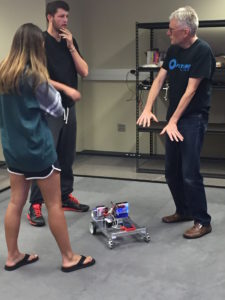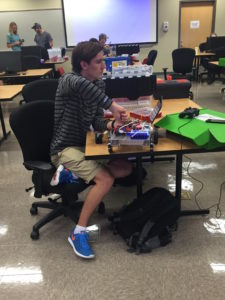Elon robotics class gears up for success
 The study of robotics can lead its pupils to a dozen different careers, from industrial building to the construction of humanoids, and the world is paying attention. Across the board, robotics is drawing attention both for its mainstream application and futuristic intrigue. Elon University is allowing students to get ahead of this trend, offering CSC 373 this fall.
The study of robotics can lead its pupils to a dozen different careers, from industrial building to the construction of humanoids, and the world is paying attention. Across the board, robotics is drawing attention both for its mainstream application and futuristic intrigue. Elon University is allowing students to get ahead of this trend, offering CSC 373 this fall.
The course, also known as Robotics, introduces students to the basics of the field and shows them how to program robots to complete certain challenges. The finished robots are expected to complete some tasks autonomously, and some with the assistance of a remote. Joel Hollingsworth, Chair of the Department of Computing Sciences, has high hopes for the future of this hands-on course.
“This class is kind of fun because you get to build something with your hands. You get to write the software and see it work,” explains Hollingsworth enthusiastically.
CSE 373 is as Hollingsworth describes it: “purely an intro course.” Currently, any students who have taken CSE 130 are eligible for the class, regardless of major or previous exposure to robotics. Hollingsworth admits that the course does present a unique set of frustrations to students.
“There are a lot of moving pieces to it,” he admits. “You’re developing software and a lot of things can go wrong. Trying to figure out how to fix those things can be difficult. But, it’s really rewarding when you do it.”
Read more examples of faculty using ATACC grants to work with technology in interesting ways.
The 2000’s have seen dozens of research articles on the power of robotics in higher education, as well as in modern society. Oxford University researchers have estimated that 47 percent of U.S. jobs could be automated within the next two decades. Due to these stunning statistics, offering students experience in robotics has become more important than ever. Elon students enrolled in CSE 373 are expected to take a wealth of knowledge out of the classroom and into the real world. Hollingsworth attests to the fact that Introduction to Robotics will enhance critical skills in computer science, programming, and problem-solving.
Of course, Hollingsworth’s department is aware that there are dangers associated with robotic machinery, and have worked to mitigate them. The course is based on the wiring of “medium-sized” robot, with the size being moderated for safety purposes. Hollingsworth explained that besides this, students are required to treat the class like a lab science; close-toed shoes and pulled-back hair are musts.
A second small roadblock CSE 373 has faced is the steep cost of funding the course.
 “Physics has run the course in the past, and they just had a couple of robotics kits. Then Computer Science wanted to join, so we bought more. It got expensive, but we think it’s worth it,” Hollingsworth remarks. “Now it’s co-funded by those two departments.”
“Physics has run the course in the past, and they just had a couple of robotics kits. Then Computer Science wanted to join, so we bought more. It got expensive, but we think it’s worth it,” Hollingsworth remarks. “Now it’s co-funded by those two departments.”
CSE 373 is also fortunate to be in part funding by an Academic Technology and Computing Committee (ATACC) grant, which used to purchase one robotics kit.
The goals for students enrolled in CSE 373 are varied; they include to enhance problem-solving skill, improve researching ability, efficiently write software and develop software kits, learn to debug existing software, and practice teamwork to accomplish jobs. The goals beyond the course extend further yet; to prepare students for a future world in which robots may be a staple of society.
 Follow
Follow